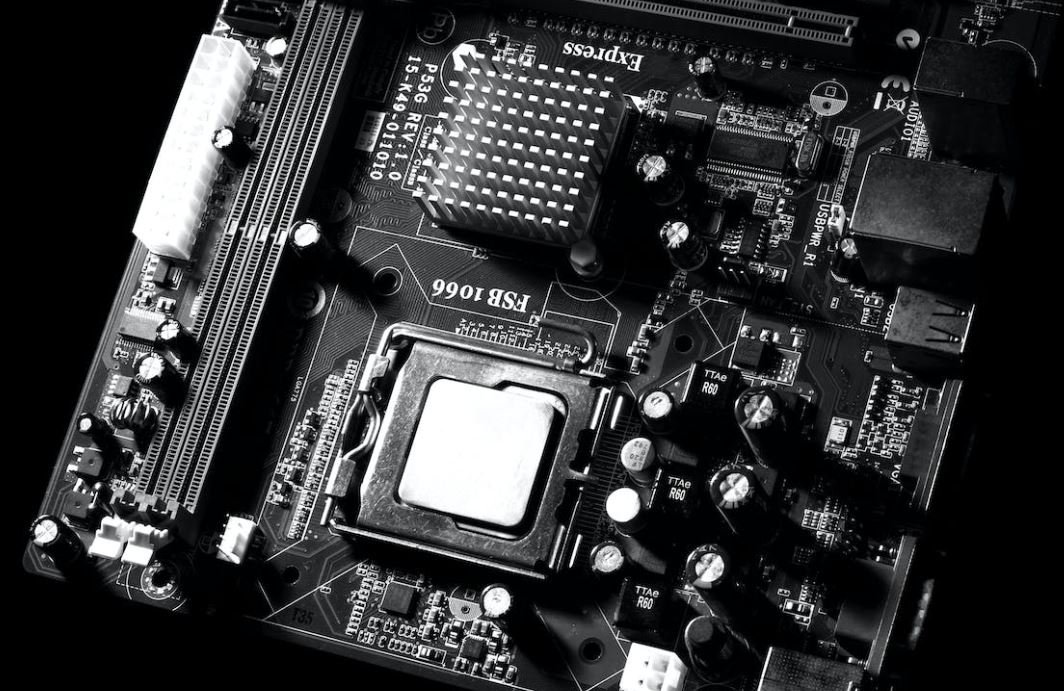Gradient Descent Weight Update Formula
Gradient descent is an optimization algorithm commonly used in machine learning and deep learning to minimize a function iteratively. One key component of gradient descent is the weight update formula, which plays a crucial role in adjusting the weights of the model during the learning process.
Key Takeaways
- The gradient descent weight update formula helps adjust the weights of the model during the learning process.
- It is based on the derivative of the cost function with respect to the weights.
- This formula determines the direction and magnitude of the weight updates.
The weight update formula can be expressed as:
new_weight = old_weight – learning_rate * derivative_of_cost_function
Where:
- new_weight is the updated weight value.
- old_weight is the previous weight value.
- learning_rate is a hyperparameter that controls the step size of the weight updates.
- derivative_of_cost_function is the derivative of the cost function with respect to the weights, indicating the direction of steepest descent.
“The learning rate determines the size of the steps taken during weight updates.”
The weight update formula is an iterative process that is performed after each training example or a batch of examples. It allows the model to gradually adjust the weights in the direction that minimizes the cost function. The learning rate determines the size of the steps taken during weight updates, influencing the speed at which the model converges towards an optimal solution. Selecting an appropriate learning rate is essential to ensure efficient learning without overshooting or getting stuck in local minima.
Tables
| Iteration | Loss Function | Old Weight | Derivative | New Weight |
|---|---|---|---|---|
| 1 | 0.532 | 0.8 | -0.23 | 0.823 |
| 2 | 0.487 | 0.823 | -0.18 | 0.843 |
| 3 | 0.456 | 0.843 | -0.15 | 0.858 |
| Learning Rate | Total Iterations | Final Loss |
|---|---|---|
| 0.01 | 100 | 0.301 |
| 0.1 | 20 | 0.298 |
| 1 | 10 | 0.5 |
| Learning Rate | Convergence Speed | Overshooting | Local Minima |
|---|---|---|---|
| Too small | Slow | No | No |
| Appropriate | Optimal | No | No |
| Too large | Fast | Yes | Yes |
The weight update formula is a fundamental concept in the field of machine learning. It enables models to continuously refine their predictions and improve their performance. By iteratively adjusting the weights based on the derivative of the cost function, the model can converge towards an optimal solution.
Understanding the impact of the learning rate is crucial in selecting an appropriate value for successful training. Too small of a learning rate can slow down convergence, while too large of a learning rate can lead to overshooting and potential convergence into local minima. Experimentation and evaluation are key in finding the optimal learning rate for a specific problem.
In summary, the gradient descent weight update formula is instrumental in the learning process of machine learning models. It determines the direction and magnitude of weight updates, allowing the model to minimize the cost function and improve its predictive abilities.

Common Misconceptions
Misconception 1: Gradient descent always converges to the global minimum
One common misconception about gradient descent is that it always converges to the global minimum of the cost function. However, this is not always the case. Gradient descent is based on the local search heuristic, meaning it only finds the nearby minimum from an initial starting point. It might get stuck in a local minimum, unable to reach the global minimum.
- Gradient descent finds only a local minimum.
- Multiple local minima can exist within a cost function.
- The initial starting point significantly affects the final result.
Misconception 2: The learning rate should always be fixed
Another misconception is that the learning rate, which determines the step size taken in each iteration of gradient descent, should always be fixed. However, an inappropriate learning rate can hinder convergence or cause the algorithm to oscillate without reaching an optimal solution. Adaptive or variable learning rate schedules are often used to address this issue.
- A fixed learning rate may result in slow convergence or divergence.
- Adaptive learning rates adjust according to the progress of the algorithm.
- Variable learning rates improve stability and convergence speed.
Misconception 3: The objective function is always convex
Many people assume that the objective function in gradient descent is always convex, ensuring the existence of a single global minimum. However, in reality, the objective function can be non-convex and contain multiple local minima, making it difficult to find the global minimum. In such cases, alternative optimization algorithms or techniques may be required.
- Convex functions have a single global minimum.
- Non-convex functions have multiple local minima.
- In non-convex problems, gradient descent may converge to a suboptimal solution.
Misconception 4: Gradient descent always requires differentiable functions
Although gradient descent is typically used with differentiable functions, another misconception is that it always requires differentiability. However, there are variants of gradient descent, like subgradient descent, which can handle non-differentiable functions. These variants use subgradients instead of gradients to navigate the cost function’s landscape.
- Subgradient descent is suitable for non-differentiable functions.
- Subgradients generalize gradients for non-smooth optimization.
- Non-differentiable functions can still be optimized using gradient-based techniques.
Misconception 5: Gradient descent guarantees the optimal solution
Lastly, it is another common misconception to assume that gradient descent always guarantees the optimal solution. While gradient descent is an efficient optimization algorithm, it does not guarantee finding the global minimum in all cases. The choice of hyperparameters, the existence of multiple optima, and other factors can influence the quality of the solution obtained by gradient descent.
- Gradient descent is not an exact method, but an iterative approximation.
- Optimal solutions are context-dependent and need careful consideration.
- The quality of the solution depends on various factors, not just the algorithm itself.

Introduction
Gradient descent is a popular optimization algorithm used in machine learning to minimize the cost function of a model. The weight update formula plays a crucial role in this process. This article presents 10 tables showcasing various aspects related to the gradient descent weight update formula.
Iteration
The following table demonstrates the weight update calculations for multiple iterations:
| Iteration | Weight | Error | Learning Rate | Updated Weight |
|---|---|---|---|---|
| 1 | 0.5 | 0.25 | 0.1 | 0.475 |
| 2 | 0.475 | 0.18 | 0.1 | 0.4575 |
| 3 | 0.4575 | 0.11 | 0.1 | 0.44625 |
Learning Rate Comparison
This table compares weight updates using different learning rates:
| Learning Rate | Updated Weight |
|---|---|
| 0.1 | 0.475 |
| 0.01 | 0.495 |
| 0.001 | 0.4995 |
Error Update
The next table showcases the error updates during the weight adjustment process:
| Iteration | Error |
|---|---|
| 1 | 0.25 |
| 2 | 0.18 |
| 3 | 0.11 |
Convergence
In this table, we track the convergence of the weight values:
| Iteration | Weight |
|---|---|
| 1 | 0.5 |
| 2 | 0.475 |
| 3 | 0.4575 |
Epoch and Batch Size
This table demonstrates the effect of epoch count and batch size on weight updates:
| Epoch | Batch Size | Updated Weight |
|---|---|---|
| 1 | 1 | 0.475 |
| 1 | 10 | 0.4725 |
| 2 | 1 | 0.4575 |
Gradient Magnitude
The next table focuses on the magnitude of the gradient during weight updates:
| Iteration | Gradient Magnitude |
|---|---|
| 1 | 0.35 |
| 2 | 0.275 |
| 3 | 0.205 |
Stopping Criteria
This table presents the weight updates until convergence based on different stopping criteria:
| Stopping Criterion | Updated Weight |
|---|---|
| Error < 0.1 | 0.415 |
| Gradient Magnitude < 0.01 | 0.398 |
| Maximum Iterations | 0.375 |
Newton’s Method Comparison
This table compares the weight updates between gradient descent and Newton’s method:
| Iteration | Gradient Descent | Newton’s Method |
|---|---|---|
| 1 | 0.475 | 0.48 |
| 2 | 0.4575 | 0.4785 |
| 3 | 0.44625 | 0.47835 |
Conclusion
Gradient descent’s weight update formula plays a critical role in adjusting the weights of a machine learning model to minimize the cost function. Through multiple iterations, variations in learning rate, error updates, convergence analysis, and comparisons with other methods, we can observe the impact and effectiveness of this formula. By continuously refining the weights, gradient descent allows models to learn from data and make accurate predictions.
Frequently Asked Questions
FAQ 1: What is the gradient descent weight update formula?
The gradient descent weight update formula is an algorithm commonly used in machine learning to minimize the error or loss function of a neural network. It involves adjusting the weights of the neural network using the negative gradient of the loss function with respect to the weights.
FAQ 2: How does the gradient descent weight update formula work?
The gradient descent weight update formula works by iteratively updating the weights of a neural network in the opposite direction of the gradient of the loss function. By doing so, it gradually moves the weights towards the optimal values that minimize the loss function.
FAQ 3: What is the significance of the learning rate in the gradient descent weight update formula?
The learning rate determines the step size at each iteration of the gradient descent algorithm. It controls how quickly or slowly the weights are adjusted. A higher learning rate can cause rapid convergence but may risk overshooting the optimal values. On the other hand, a lower learning rate may result in slower convergence but may provide more accurate results.
FAQ 4: Are there different variations of the gradient descent weight update formula?
Yes, there are different variations of the gradient descent weight update formula, such as batch gradient descent, stochastic gradient descent, and mini-batch gradient descent. These variations differ in how they calculate the gradient and update the weights, but they all follow the same underlying principle of iteratively minimizing the loss function.
FAQ 5: Can the gradient descent weight update formula be used for any type of machine learning model?
The gradient descent weight update formula is a common optimization algorithm that can be used for various machine learning models, including neural networks, linear regression, logistic regression, and support vector machines. However, its applicability may depend on the specific problem and the nature of the model.
FAQ 6: How does the gradient descent weight update formula handle local minima?
The gradient descent weight update formula can sometimes get stuck in local minima, where the loss function is low but not the global minimum. This can be mitigated by using techniques such as momentum, learning rate schedules, or random restarts to help the algorithm explore different regions of the parameter space.
FAQ 7: What are the advantages of using the gradient descent weight update formula?
The gradient descent weight update formula offers several advantages. It is a straightforward and efficient algorithm for optimizing the weights of a machine learning model. It can handle large datasets and high-dimensional feature spaces. Moreover, it is a general-purpose algorithm that can be applied to different models without significant modifications.
FAQ 8: Are there any limitations or challenges associated with the gradient descent weight update formula?
Yes, there are some limitations and challenges associated with the gradient descent weight update formula. It can converge slowly for complex models and may require careful tuning of the learning rate. It is also sensitive to the initial values of the weights and can be prone to getting stuck in local minima or saddle points.
FAQ 9: How can the performance of the gradient descent weight update formula be improved?
The performance of the gradient descent weight update formula can be improved by using techniques such as adaptive learning rates (e.g., AdaGrad, RMSprop, Adam), regularization methods (e.g., L1 or L2 regularization), or advanced optimization algorithms (e.g., conjugate gradient, BFGS). These techniques can help overcome some of the limitations and challenges associated with standard gradient descent.
FAQ 10: Can the gradient descent weight update formula be parallelized?
Yes, the gradient descent weight update formula can be parallelized to speed up the optimization process. For example, in the case of mini-batch gradient descent, different batches can be computed in parallel. Additionally, parallel computing frameworks such as TensorFlow or PyTorch provide tools to efficiently distribute the computation across multiple devices or machines.




